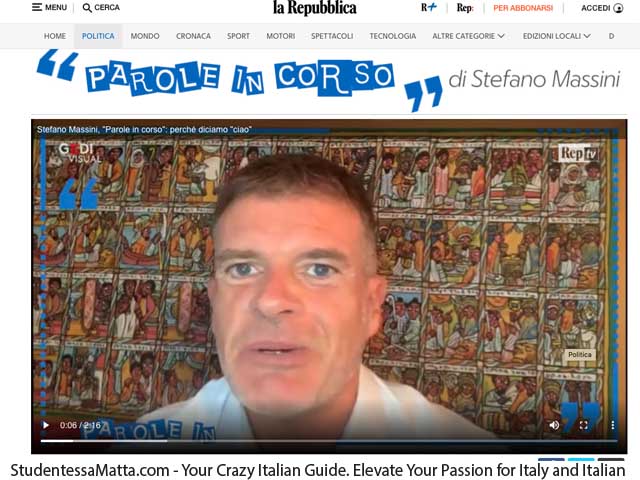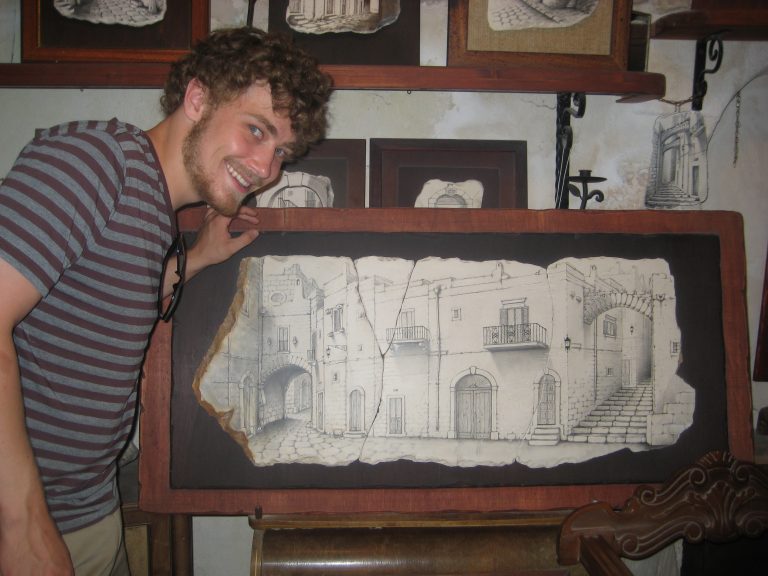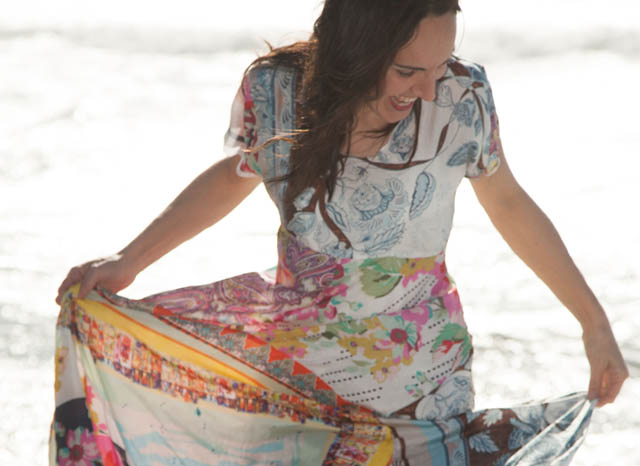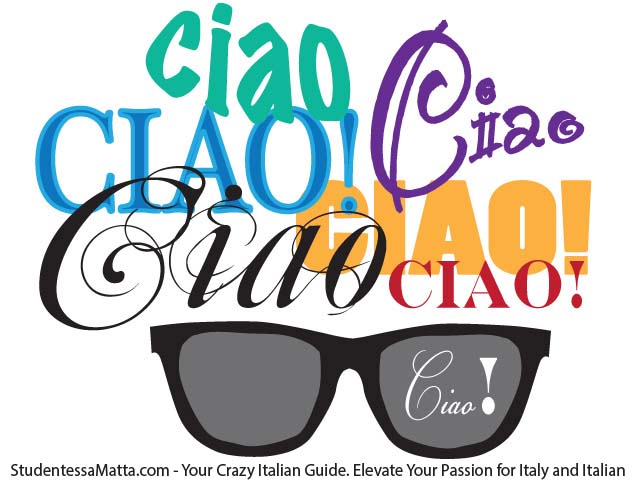
Che tu stia arrivando o uscendo, atterrando o decollando, ti stia imbarcando o sbarcando non puoi sfuggire la parola “Ciao!” È ovunque tu vada, da Roma alla terra tailandese!
Whether you are coming or going, flying in or flying out, embarking
or disembarking you can’t escape hearing the word “Ciao!”
It is everywhere you go, from Rome to Thailand!
“Ciao! Come stai? Bene, grazie! A dopo! Basta sentire la parola “Ciao” per evocare un’immagine di Marcello Mastroianni, vestito con un abito Armani, con occhiali da sole Prada. Mentre il saluto ti esce di bocca, vedi anche Anita che danza presso una fontana progettata da Bernini, e Audrey che gira per Roma su una vespa color rosso brillante. Se sento pronunciare semplicemente due parole separate: “Ciao Ciao!” mi viene in mente un bar della zona, il tintinnio delle tazze di caffè e giuro che riesco sentire l’odore di un espresso appena preparato e un cornetto caldo.
“Ciao! Come stai?! Bene, grazie! A dopo! Ciao! Simply hearing the word “Ciao” is enough to conjure up an image of Marcello Mastroianni, dressed in an Armani suit, sporting dark Prada sunglasses. As the greeting rolls off your tongue you also have visions of Anita dancing in a fountain carved by Bernini and Audrey roaring around Rome on a bright red vespa. Simply uttering the two staccato sounds: “Ciao Ciao!” brings to mind corner bars, clinking coffee cups and you swear you can smell the scent of a freshly brewed espresso and a warm “cornetto”.
Questo iconico saluto italiano si è fatto strada in quasi tutte le lingue contemporanee ed è universalmente compreso.
Questo iconico saluto italiano si è fatto strada in quasi tutte le lingue contemporanee ed è universalmente compreso. È il saluto casual che rappresenta una moderna generazione informale. C’è la stessa probabilità di sentire il saluto sia per le strade della moda di Milano che in uno studio cinematografico di Hollywood. “Ciao! ““Pranziamo e firmiamo l’accordo per il film!” La parola si è diffusa come un fuoco selvaggio, e ha fatto il giro del mondo, diffondendosi. Quanto è figo ciò che si manifesta in una conversazione ovunque. Naturalmente ci sono altri saluti italiani che si possono usare, come “Salve!”, “Buongiorno!” “Buona giornata!”, “Buondì!”, “Buonasera!” e “Buonanotte!”, “Arrivederci”! “Pronto!” … ma nessuno di questi è affascinante o accattivante come la parola “Ciao!”
This iconic Italian greeting has worked its way into almost all contemporary languages and is universally understood. It is the casual greeting that epitomizes a modern informal generation. You are just as likely to hear the salutation on the fashion streets of Milano, as on a backlot movie studio in Hollywood. “Ciao! Let’s do lunch and sign that movie deal!” The word has spread like wildfire and has circled the globe spreading Italian “coolness” everywhere it pops up in conversation. Of course, there are other Italian greetings that you can use, like “Salve!”, “Buongiorno!”, “Buona giornata!”, “Buon dì!”, “Buona sera!” and “Buona notte!”, “Arriverderci”!, “Pronto!”…but none of these are swanky, or as endearing as the word “Ciao!”
“Ciao!” nella lingua italiana è un piccolo saluto utile per ogni occasione.
“Ciao!” in nella lingua italiana è un piccolo saluto utile per ogni occasione. Non importa la posizione sociale, non import se spazzi le strade con una scopa o se indossi una corona, porti uno scettro e ti siedi su un trono. Puoi usare “Ciao” in situazioni informali che richiedono l’uso del “tu”, come quando saluti il tuo cane o tua nonna novantenne. Puoi anche usarlo per situazioni più formali in cui l’uso del pronome “lei” è più appropriato. Ad esempio, quando si incontra il presidente della Repubblica. Quindi, rilassati! Non ti troverai mai nei pasticci dicendo la parola “Ciao.” Che tu stia salutando un collega di lavoro in via Cavour a Roma, o stia salutando il fidanzato all’ aeroporto di Fiumicino…Ciao-is-the-word!
In the Italian language “Ciao” is a convenient and serviceable little salutation that can be used on any occasion. It doesn’t care about your position in society, if you sweep streets with a broom, or if you wear a crown, carry a scepter and sit on a thrown. You can use “Ciao” in informal situations that require the “tu” form, as when you greet your dog or your ninety-year-old grandmother. You can also use it for more formal situations in which the use of the “Lei” form is more appropriate. For instance, when meeting the president of la Repubblica. So, relax! You will never find yourself “in un pasticcio” (in trouble) saying the word “Ciao”. Whether you are greeting a business colleague on via Cavour in Rome, or waving goodbye to “un fidanzato” (boyfriend) at Fiumicino airport… “Ciao-is-the-word”!
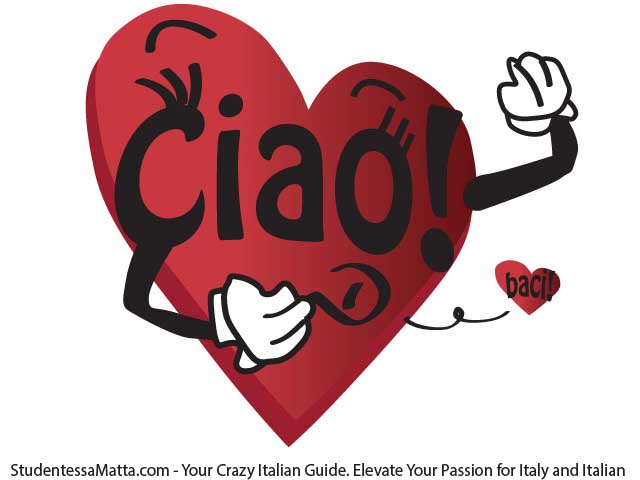
In origine, l’espressione “Ciao” si è evoluta dal dialetto veneziano dalla frase “s-ciào” che significa “Io sono il suo schiavo.” L’espressione non implicava letteralmente l’idea… il senso è: “Ogni suo desiderio è un ordine per me!” In seguito la parola è stata usata come per esprimere un sentimento di fraternità tra amici, un po’ come “sono al suo servizio” in inglese. Se vuoi diventare veramente esperto e scavare intorno all’etimologia della parola “Ciao” scoprirai che la parola veneziana per “schiavo” o “s-ciào” deriva dal latino medievale “sclavus”. Questa parola può quindi essere ricondotta alla parola che indica l’etnia slava, poiché la maggior parte degli schiavi veniva dai Balcani.
Originally the expression “Ciao” evolved from the Venetian dialect from the phrase “s-ciào” which means “I am your slave”. The expression did not literally imply the notion: “il tuo desiderio è il mio ordine!” (your wish is my command!) Instead the word was used as a means of expressing good will among friends, kind of like “I’m at your service” in English. If you want to get really technical and dig around the etymology of the word “Ciao” you will discover that the Venetian word for “slave” or “s-ciào” derives from the Medieval Latin word “sclavus”. This word can then be traced back to the ethnic slavic word for slave since most slaves came from the Balkans.
Nel corso del tempo (e di molte gite in gondola) il saluto veneziano “s-ciào” fu infine abbreviato in “Ciao”, e perse completamente la sua connotazione servile. Durante i giorni d’oro della Repubblica Veneziana, il saluto si è fatto fatto crescere le gambe e ha vagato su e giù per la penisola italiana, trovando terreno fertile in ogni punto in cui arrivava. Alla fine, “ciao” si fece strada anche in Europa, portando il suo caratteristico calore italiano nelle fredde capitali del nord. Verso la fine del XIX e l’inizio del XX secolo la parola “Ciao”, insieme ad altri emigranti italiani avventurosi, salì a bordo di barche dirette verso le Americhe, al di là dell’Atlantico. È sbarcata nei porti di tutto il Sud America, entrando in paesi come Colombia, Uruguay, Ecuador e Perù. A Cuba “Ciao” è diventato così popolare, che alla fine ha sostituito il saluto Cubano “Adiòs”. Il saluto ha continuato a viaggiare in alto mare, fino a raggiungere alla fine anche la grande barriera corallina, insieme agli emigranti italiani che si stabilirono in Australia all’inizio del XX secolo.
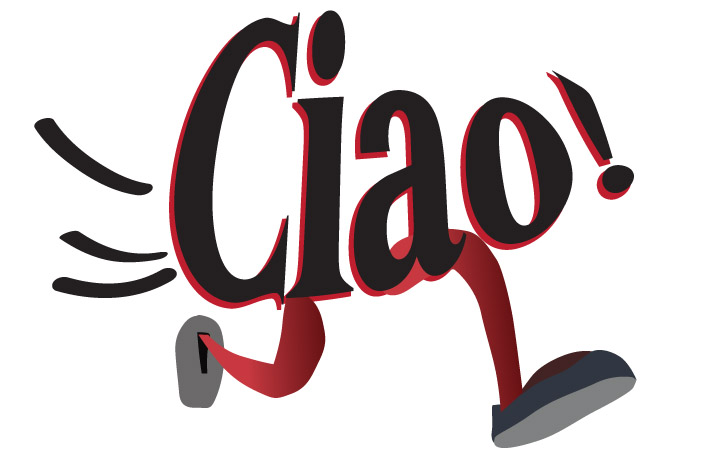
Overtime (and many gondola boat rides later), the Venetian greeting “s-ciào” was eventually shorted to “Ciao” and completely lost its servile connotation. During the golden days of the Venetian Republic, the greeting grew legs and wandered up and down the Italian peninsula, making friends wherever it decided to rest its hat. Eventually, it hiked its way into Europe, bringing its distinctive Italian warmth to chillier northern capitols. By the late 19th and early 20th centuries, the word “Ciao” and other adventuresome Italian emigrants, boarded boats headed across the Atlantic to the Americas. It disembarked in ports all over South America, making its entry into countries like Colombia, Uruguay, Ecuador, and Peru. In Cuba, “Ciao” became so popular that it replaced the Cuban greeting “Adiòs.” The salutation continued to set sail on the high seas until finally reaching the Great Barrier reef and the Italian Emigrants who settled in Australia during the early 20th century.
Come mai la parola “Ciao” si sente anche sulle spiagge di Staten Island, e ai piedi della Statua della Libertà? Ecco un fatto curioso! Fu un romanzo di Ernest Hemingway, “A Farewell to Arms,” scritto nel 1929 e ambientato in Italia durante la prima guerra mondiale, che rese popolare il termine “Ciao” in lingua inglese.
How did the word “Ciao” wash up on the shores of Staten Island, at the very feet of the Statue of Liberty? Here’s a fun fact! Ernest Hemingway’s World War I novel “A Farewell to Arms” was written in 1929 and set in war-torn Italy, which popularized the term “Ciao” in the English language.
Come si può vedere, la parola “Ciao!” è abbastanza versatile e molto simile al saluto hawaiano “Aloha”, che è un saluto di benvenuto e un saluto di commiato. La cosa affascinante della parola “Ciao” è che ha molte varianti, e a seconda dell’intonazione, e di come la si usa, può enfatizzare l’amicizia come in “Ciaaaaaooooo! Sono contenta di vederti di nuovo… !al più civettuolo “Ciao bella!! Mi piacciono i tuoi occhi… vuoi uscire con me stasera?”
As you can see, the word “Ciao!” is quite versatile and very similar to the Hawaiian greeting “Aloha,” which also means “Hello!” and “Goodbye!”. The charming thing about the word “Ciao” is that it has a lot of personalities. Depending on your intonation and how you use the word, it can emphasize friendship as in “Ciaaaaooooo” sono contenta di vederti! (Hiii! I am so happy were bumped into each other!) to the the more flirtatious “Ciao bella! Mi piacciono i tuoi occhi…Vuoi uscire con me stasera?” (Hey babe! I like your eyes…do you want to go out with me tonight?”)

L’uso di un doppio “Ciao Ciao” significa specificamente “arrivederci” e l’urgenza del tuo addio viene accentuate se tripli o quadruplica la parola “Ciao ciao ciao ciao” si traduce in “devo andare, ho fretta!”
Using a double “Ciao Ciao” means explicitly “Goodbye,” The urgency of your goodbye is heightened if you triple or quadruple the word. “Ciao ciao ciao ciao” translates to “Gotta go, I’m in a hurry!”
Allora! Ora che hai “lo scoop” sulla parola “Ciao!” io devo scappare!!!! Ciao ciao ciao ciao CiAAaaOooooOo! Allora! Now you have the scoop on the word “Ciao!” “Adesso devo scappare!” (And now it’s time for me run!) Ciao ciao ciao ciao CiAAaaOooooOo!
Allora! Now you have the scoop on the word “Ciao!” “Adesso devo scappare!” (And now it’s time for me run!) Ciao ciao ciao ciao CiAAaaOooooOo!
Take a listen to Stefano Massini
who talks about this very subject too!
